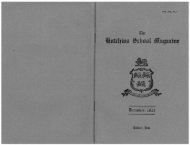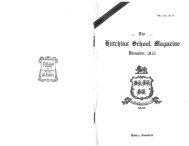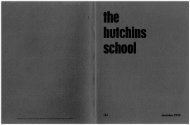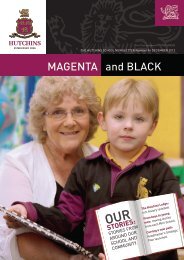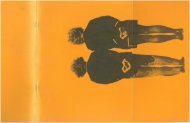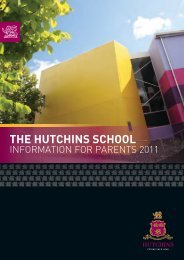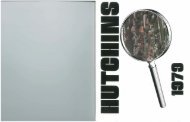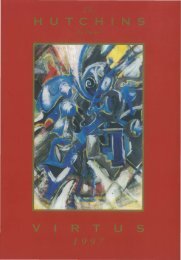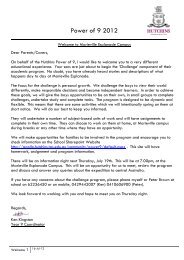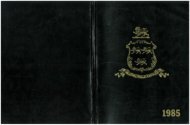1970 September.pdf - What's On at Hutchins...
1970 September.pdf - What's On at Hutchins...
1970 September.pdf - What's On at Hutchins...
- No tags were found...
You also want an ePaper? Increase the reach of your titles
YUMPU automatically turns print PDFs into web optimized ePapers that Google loves.
to the Rev G. Lennard, both for allowing usthe use of his church and for his particip<strong>at</strong>ionin our services.A number of boys, namely G. Abbott, 1.Black, A. Gibson, D. Palmer, F. Simpson, T.Wilson and S. Young showed their willingnessto serve community needs by acting as buttonsellers during the May holidays on behalf ofthe Hobart District Nursing Service.Two Schools' Concerts have been <strong>at</strong>tendedby boys of the Middle School so far this year.Both proved interesting and instructive.Collections from Middle School classesduring Lent totalled $46.31, a fine effort.Monthly collections in support of CanonMolesworth of Swaziland have totalled so farthis year the sum of $27.40. In both instancesall boys of the Middle School have contributedregularly.62Lunch time activities have been varied. Wehave an Indonesian Club, a Chess Club, aL<strong>at</strong>in Club and a Choral Group. Informalg<strong>at</strong>herings for playing of records have alsoreceived support.The following boys have received MeritCards for academic excellence based onmonthlv assessments:2L-C. Cranswick, R. Jarvis, M. King, C.Mackey, M. Pascoe, N. Tapson.2M-T. Baird, R. Buchanan, P. Dunn, A.Gibson, C. Johnston, S. Valentine.2P-T. Bennetto, A. Goodwin, J. Julian, J.Linton, C. Mace, M. Thorpe.3B-G. Abbott, C. Cheshire, A. Gill, M.Grover, M. Samson, J. Weaver.3G-J. Gibson, S. Glenn, S. Gumley, R.Robinson, M. Sweetingham, A. Westbrook.3H-S. Eslake, M. Foster, R. Hewer, A.Jevtic, 1. Middleton, J. OtIowski, D. Peters.A NEW SPECIES OF RICHEAEditor's Note-The following is an account of a new species of plant found in a previouslyonce-reported area of Southern Tasmania by m<strong>at</strong>ricul<strong>at</strong>ion student, David Zeigeler. Thefind is particularly significant in th<strong>at</strong> it demonstr<strong>at</strong>es keen obsem<strong>at</strong>ion and an inquisitivenessth<strong>at</strong> are essential to serious n<strong>at</strong>ltralist studies. David is an active member of the TasmanianField N<strong>at</strong>uralists Society. The following is his account of the description of the plant.IN recent years a new species of Richea has 39, page 130. My own observ<strong>at</strong>ion of abeen discovered, Richea species nova. It specimen which I found <strong>at</strong> Hartz Mountainsresembles both Richea scorparia and Richea N<strong>at</strong>ional Park in November, 1969 was th<strong>at</strong>dracophylla but differs from the two species the shrub was about 2 feet 8 inches high,by two main points:compact in foliage form<strong>at</strong>ion and considerably(a) "from R. scoparia in th<strong>at</strong> the leaves are branched. The shru~ was not in flower butvery much larger and scarcely pungent and there were several.wIt~eredflowerheads presusuallyrecurved, <strong>at</strong> least the lower ones. ent. I~ was growmg m the company of ~.The flowers differ in th<strong>at</strong> the lower pedicels scopa1'1a by a small. tarn (small mou~tamof the fioyver spike are elong<strong>at</strong>ed and the lake), on a badly dramed plam <strong>at</strong> an altItudedistances between these lower pedicels are of about 3,500 feet. .gre<strong>at</strong>er than those of the upper ones, which My.find was the second. find o~ tI1lS rareare more or less crowded together. The upper plant In the Hartz MountaI~s N<strong>at</strong>I<strong>On</strong>al P~rk.pedicels are almost sessile (lacking a stem). It ?as also been fou?d In Mount FIeldThe corolla (flower head), is somewh<strong>at</strong> fl<strong>at</strong>- N<strong>at</strong>I<strong>On</strong>al Park, Wherrett s Looko~t, Lake Fentenedand smaller than th<strong>at</strong> of R. scoparia- ton and Lake Dobson, as well as In the Cradle, Mountain N<strong>at</strong>ional Park.(b) from R. drac?phylla prim:=trily in the The genus Richea belongs to the plantfact th<strong>at</strong> the leaves, Instead of beInbet confined f '1 E'd h' h d 'b d1 d f. amI y pacn aceae w IC are escn e asso t 1e en s a the branches are perSIstent on evergreen shrubs and often he<strong>at</strong>h-like. Thisall th~ stems, although they. are dead and family includes about 30 genera and 400decaymg on. tl~e l~wer two-tl:u'ds or so. !he species. mainly Australian, but with a fewleaves are SImIlar In shape, SIze and carnage etenera . . Ne Z I d N C 1d' dthough more riaid." , ,.., In. W e:=t an, ew a e. oma anb Malaya. Rlchea Include 11 speCIes, 10 ofThe description of the differences is taken which are endemic to Tasmania and one fromfrom Australian Plants, Volume 5, Number Victoria.THE VOICEOF THESCHOOLORIGINAL CONTRIBUTIONSA JOURNEY IN MUDIt was hot and humid as the old schoolbus r<strong>at</strong>tled along the Gordon River road.There were thirteen of us, not including theMaster. Suddenly one of the boys who hadpreviously turned white was sick all over ourrucksacks.The bus driver put on the brakes, and allof the boys piled out holding their noses. \iVewere also lucky th<strong>at</strong> there was a streamnearby so we washed out the bus and rucksacks.The back inside tyre of the bus waspunctured, so we amused ourselves by throwingstones <strong>at</strong> some ponds about fifty yardsaway down the hill. The puncture was soonmended and we continued on.We soon arrived <strong>at</strong> the Lake Pedder trackso we disembarked and started off.After fixing our packs we set out on theseven hour walk. As it had rained on theprevious day, the ground was very muddy andin the first few hundred yards we ploughed,literally ploughed, through the slimey mudwhich was up to our knees and it was alsovery steep so we tired very quickly.It was about one and a half miles to thesaddle which was about one thousand fivehundred feet high, above the road.The downhill climb was much easier butit was even muddier and our heavy packstended to overbalance us. We kept up agood pace, and reached the bottom in aboutan hour. From about half-way down therewas no track, so we had to follow a stream.The track soon showed itself and we continued on our way.We were now on the button grass plain,and the mud was even thicker, so the paceslowed down considerably. <strong>On</strong>e of the boyslost his boot, about one foot down in mud.This gave us a temporary halt and a chance63to thankfully take a rest while the other boyslooked for the boot.It was found after nearly every <strong>at</strong>om inth<strong>at</strong> mud p<strong>at</strong>ch was overturned and thenwalking continued. After crossing CrummyCreek there was very little mud for the nextfour hours so we covered it in reasonable time.It was very exhausting and r<strong>at</strong>her monotonousbecause of the acres and acres of button grassall around.The monotonous surroundings soon changedwhen the wide plain changed into a narrowvalley. There was also an acre or so of slimy,sloshy, mess of mud and one of the tall boyswent down about three and a half feet inmud before he was pulled out.Then we met a very tiring hill. It wasabout one thousand feet high, off the plainand <strong>at</strong> an angle of about fifty degrees, whichis very steep. From the saddle we saw thelarge expanse of the lake, the white beaches,and the very rocky mountains th<strong>at</strong> rimmedthem. Unfortun<strong>at</strong>ely the day was very gloomyso there weren't any cameras out.The descent was also very muddy and wefollowed a creek again. It consisted of aboutone foot deep w<strong>at</strong>er and the same thicknessof mud.We crossed the river to the camp site andjust had time to erect the tents, have tea andunpack our packs before dark. We were allso tired th<strong>at</strong> we sank into our sleeping bagsand went to sleep dreaming of mud.B. R. Slade, IVoTHE EARTHQUAKEI could hear the squeaking of the elev<strong>at</strong>oras it zoomed on its way up to the 38th floor.<strong>On</strong> the way up we stopped <strong>at</strong> the 10th floorto pick up a few more people and drop acouple. We then continued up to the 23rdfloor where it stopped several feet higher thanthe doorway. Just then a crippling jolt wasfelt by all when it stopped. Screams andshouts came from the people who werecrowded into the elev<strong>at</strong>or as they tried toget to their feet. The expressions on theirfaces were terrifying and an old lady in thecorner was having hysterics. Fearsome andfrightening thoughts went through us all.There we were in the darkness while thelift trembled and shook as if it were an earthquakein itself. My friend managed to climb



